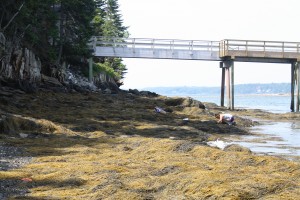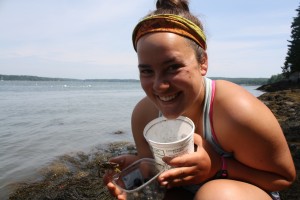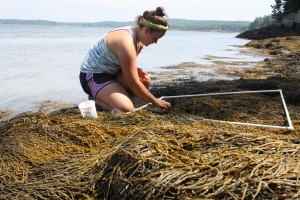 I am studying Rockweed (Ascophyllum nodosum) harvesting in the Gulf of Maine, both at the Coastal Studies Center in Harpswell, ME and on Kent Island in the Bay of Fundy. Rockweed is harvested commercially for use in fertilizers, food additives, and some other minor industries; landings have been increasing in recent decades and there is a growing concern over how harvesting activities are affecting the ecosystem.
I am studying Rockweed (Ascophyllum nodosum) harvesting in the Gulf of Maine, both at the Coastal Studies Center in Harpswell, ME and on Kent Island in the Bay of Fundy. Rockweed is harvested commercially for use in fertilizers, food additives, and some other minor industries; landings have been increasing in recent decades and there is a growing concern over how harvesting activities are affecting the ecosystem.
Rockweed beds are essentially the old-growth forest of the intertidal zone, much like the Amazon rainforest in South America. Young algae sporelings settle onto rocks only during rare low-flow conditions, and once attached grow very slowly (approximately 6-10 cm per year). For a plant that regularly reaches two meters in length, this means that the fronds alone are several decades old, while holdfasts have been shown to live for centuries.
Although rockweed beds may look like a nondescript slimy olive-green mass just waiting to sprain an ankle the second one sets foot on their slippery surface, it is far from the “weed” that its name suggests. Rockweed is tough and chemically well defended, making it unappetizing for the run-of-the-mill intertidal herbivore. It forms an important habitat for a variety of organisms: periwinkles, crab, dog whelks, amphipods, isopods, bryozoans, and nudibranchs are all found within its holdfasts and fronds, while shorebirds and Eider ducklings forage in it. Juvenile fish, many of which are commercially important, spend part of their life cycle in the rockweed. It acts as an important buffer against the stress of extreme temperature fluctuation, desiccation, and wave stress of the intertidal zone, and it is also important for cycling nutrients and energy through the ocean ecosystem. While A. nodosum plays many important roles within the ecosystem, it is still important to note that it is the competitively dominant seaweed of the intertidal zone and reduces other algal diversity (but few intertidal seaweeds have the same mature biomass and complexity levels of rockweed).
Because of the complex role of Ascophyllum nodosum in the intertidal ecosystem, its harvest naturally begs the question—what is the ecological impact of cutting rockweed? My research is focused on answering this question in a general sense. I am using a BACI (Before, After, Control, Impact) experimental design where I have set up paired 2x2m plots. I survey both, cut one to the 16 inch minimum length required by the Maine DMR, then survey them again immediately following and at one-month intervals after harvest. Surveys involve noting plot characteristics (slope, substrate, vertical height, etc.), identifying all algal species present, and identifying and counting all other organisms in a 1 m2 quadrat placed in the center of each 2x2m plot.
In addition to this I am monitoring the regrowth of the Ascophyllum after it has been cut. I generally find a few staple organisms in each plot—Littorina spp.(periwinkles), Carcinus maenas (green crabs), Nucella lapillus(dog whelks), Semibalanus balanoides (barnacles), Mytilus edulis (blue mussels), amphipods and isopods (small crustaceans which look very much like insects) Fucus vesiculosus (another type of rockweed), Chondrus crispus (a red algae), and Lithothamnium (an encrusting pink algae). However, sometimes other creatures also are found in lower densities and add a pop of excitement to my day—nudibranchs (sea slugs) are my personal favorite, and I have also found sea stars, sea urchins, scale worms, and a rock gunnel.
My work at the Coastal Studies Center is part of a comparative study between Maine and Kent Island, located in the Bay of Fundy on the border between Maine and Canada. My experimental design is essentially the same at the two study sites, although I established study plots on Kent Island in 2013 and have been tracking them for a year at this point. My hope is to collect long-term data from Kent Island, and also to compare the effects of cutting Ascophyllum nodosum between to relatively different locations. Kent Island experiences 28-foot tides (as compared to the 9-foot tides in Harpswell), and the intertidal zone supports a very dense, mature rockweed bed that has never been harvested, while the rockweed at the Coastal Studies Center is much less prolific. Past studies looking at rockweed harvesting have drawn varied conclusions, and conducting a comparative study will help to determine whether some of these differences are due to site-specific variation.
 I do not have any results for my work at the Coastal Studies Center as of yet, but the data from Kent Island indicates that the harvested plots have regained little of the length and biomass that was removed a year ago. A general reduction in most invertebrate abundances (amphipods, periwinkles and crabs being the most outstanding) that persists a year following harvest was observed. Algal biodiversity increases after a year, suggesting that removing the competitively dominant algae stimulates other algal growth. I plan to follow the Kent Island plots into September, and the Coastal Studies plots for as long as the weather permits (Maine winters being what they are, this might not be much later than September). My data will be used for a Senior Honors Project.
I do not have any results for my work at the Coastal Studies Center as of yet, but the data from Kent Island indicates that the harvested plots have regained little of the length and biomass that was removed a year ago. A general reduction in most invertebrate abundances (amphipods, periwinkles and crabs being the most outstanding) that persists a year following harvest was observed. Algal biodiversity increases after a year, suggesting that removing the competitively dominant algae stimulates other algal growth. I plan to follow the Kent Island plots into September, and the Coastal Studies plots for as long as the weather permits (Maine winters being what they are, this might not be much later than September). My data will be used for a Senior Honors Project.
For a review of rockweed harvesting, see Seeley and Schlesinger (2012): Sustainable seaweed cutting? The rockweed (Ascophyllum nodosum) industry of Maine and the Maritime Provinces. Annals of the New York Academy of Sciences. 1249: 84-103.
My research has been supported by the Bowdoin Scientific Station Fellowship and the Rusack Coastal Studies Fellowship.
Project Advisors: Damon Gannon, PhD and Amy Johnson, PhD.
